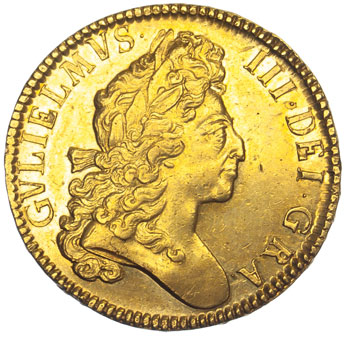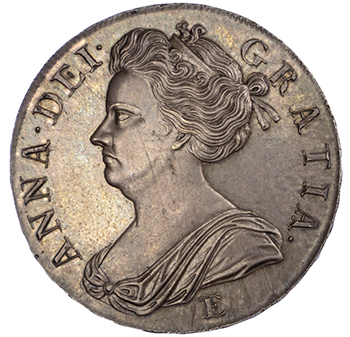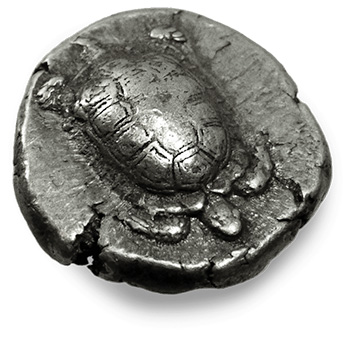THE BRITISH COINS
A Controversial Coin

In 1893 the gold and silver coinage of Victoria was redesigned. The Joseph Boehm portrait of the Queen was a little controversial, and the small crown perched upon the Queen’s head was not universally popular. Consequently, the engraver Thomas Brock (1847-1922) was given the task of producing what would become the last coinage portrait of this lengthy reign.
THE SINGLE COIN WORTH THREE MONTHS WAGES

The Triple Unite, valued at sixty shillings, or three pounds, was the highest English hammered denomination to be produced. It was struck at the Oxford Mint set up during the first English Civil War of 1642-6 and issued was issued, at least in part, for use as gifts to those whom the King wished to ‘cement’ to his side in the Civil War.
TO HOLD ONE YOU HAD TO BE NOBLE

Most people at this time would never have a chance to see this coin. The Elizabeth I Sovereign (1584-6) was considered such a remarkable coin that it was rarely seen outside of noble circles. Unlike most gold and silver coins, which changed hands often, the Elizabeth I Sovereign was reserved for appearances in Court and special occasions. In some instances, a Sovereign was given personally by the queen to respected playwrights and actors after a performance – a gift never to be spent in the lifetime of the recipient.
A GREAT RARITY IN THE WORLD OF ENGLISH COINS

The Cromwell gold Broad of Twenty Shillings is a great rarity in the world of English coins, especially when they are retained in such fine condition. As a historic memento from the English Civil War, this collector’s piece is highly sought-after by rare coin enthusiasts and aficionados of this important time in British history.
A HANDSOME COIN OWNED ONLY BY THOSE WHO DESERVED IT

This five-Guinea was the largest of the gold coins of the reign of William III. A handsome coin with a boldly lettered edge, which few could afford to keep and which was produced in relatively small numbers. Few have survived in the condition of this specimen.
THE QUEEN WHO BROUGHT ABOUT THE UNION OF ENGLAND AND SCOTLAND

Queen Anne came to power as the Queen of England, Scotland and Ireland in 1702, after the death of her brother in law King William III. She reigned until 1707 when the Acts of Union joined the crowns of England and Scotland under one title and gave Queen Anne the order; Queen of Great Britain and Ireland, which she held until her death in 1714.
THE PATTERN THAT BECAME ONE OF THE MOST SOUGHT AFTER BRITISH COINS

King George III was the ruler of Great Britain and Ireland from 1760 until his death in 1820. His reign was one of conflict, with wars arising across the world with the continual expansion of the British Empire. Early in King George III’s reign he won the Seven Years’ War against France in 1763, making Britain the dominant power in North America and India.
THE PENNY THAT NEVER SAW THE LIGHT OF DAY

In 1933 the Royal Mint decided to temporarily cease the production of pennies. This was due to a surplus of the coin already in circulation. Millions of Victorian and Edwardian pennies still changed hands in the 1930s.
Despite the lack of necessity, it was still decided to strike a small number of pennies in 1933.
THE ANCIENT COINS
HE SLEPT, ATE AND FOUGHT BY YOUR SIDE. A LEADER BUILT BY ROMe

Hadrian believed the army should be kept busy, as well as being ruled strictly and frugally. The leader was no hypocrite when it came to these opinions. On his travels around the empire, he impressed the army by living just like them, sleeping rough and eating the same rations as the soldiers, in stark contrast to the common opinion of Hadrian as a high-minded, cultured traveller of the classical world.
A TERRESTRIAL GREEK HERO

Aegina, a Saronic Islands of Greece, named after a Greek hero and king was a rival of Athens. The first Greek state to adopt coinage, Aegina struck a distinctive sea turtle on its coins. The design was soon changed in a humiliating admission of defeat.
People of the camp

Southern Italy and Sicily were targeted by Greek city-states during the early centuries of the 1st Millennium BC. They sent out explorers and formed colonies and later cities, inhabited by Greeks, in what would become Magna Graecia or Greater Greece. These cities went on to strike their own coins. By the 4th Century BC, another ancient powerhouse, Carthage (modern-day Tunis, in Tunisia) had its sights set on the island.
KING CORIO (CIRCA. 25 BC – AD 5)

A tribe pieced together by gold. We know very little about the mysterious world of Iron Age or ‘Celtic’ Britain. Such little evidence has been left for us, but we can piece together a little of Iron Age society through a vital piece of evidence – coins.
WOULD YOU ACCEPT A PIECE OF GOLD TO SECURE YOUR LOYALTY?

Philip II was a king of Macedonia from 359 to 336 B.C. He became the sole ruler of an empire that was greatly built on by his son, Alexander the Great. Philip ruled as Hegemon over mainland Greece and many of the islands. He issued gold staters to pay the many Celtic mercenaries who helped him achieve his conquests.
THE BRITANNIA SESTERTIUS

Southern Italy and Sicily were targeted by Greek city-states during the early centuries of the 1st Millennium BC. They sent out explorers and formed colonies and later cities, inhabited by Greeks, in what would become Magna Graecia or Greater Greece. These cities went on to strike their own coins. By the 4th Century BC, another ancient powerhouse, Carthage (modern-day Tunis, in Tunisia) had its sights set on the island.
THE FIRST PHILOSOPHER EMPEROR, BELOVED BY ALL

Marcus Aurelius is one of the most well known Roman emperors, he is considered the last of Rome’s five good emperors and he was popular with the Roman people and the Senate. He fought campaigns against Germanic tribes, but also famously embraced Stoicism, becoming the first ‘Philosopher’ emperor.
THE EMPEROR THAT REFORMED ROME AND ENDED A CENTURY OF CRISIS

Constantine the Great was the ruler of the Roman Empire between 306 and 337 AD. His rule was a turning point in the Roman Empire. He introduced widespread economic and social reforms that helped end a century of crisis in the Roman world. He also most importantly allowed a religion which had been shunned by Roman society for decades come to light.

